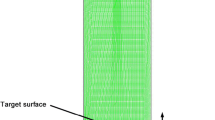Abstract
In the erosion-free zone that appears during high-amplitude ultrasound treatment, the useful work is mainly performed by cavitational clusters. In the absence of collapse, the clusters grow and produce small-scale turbulence. As shown in the present work, cavitational clusters may be activated by the additional acoustic pressure arising when a low-amplitude source is coaxial with the high-amplitude source.





Similar content being viewed by others
REFERENCES
Livanskiy, A.N., Prikhodko, V.M., Sundukov, S.K. et al., Research on the influence of ultrasonic vibrations on paint coating properties, Trans. FAMENA, 2016, vol. 40, no. 1, pp. 129–138.
Grib, V.V., Levushkina, N.V., Nigmetzyanov, R.I., et al., Ultrasound production of foams used for washing of mechanical engineering products, Vestn. MADI, 2017, no. 1 (48), pp. 43–49.
Kazantsev, V.F., Kuznetsov, S.Y., Sundukov, S.K., et al., Ultrasound treatment of curved contours and complex surfaces, Russ. Eng. Res., 2017, vol. 37, no. 12, pp. 1074–1076. https://doi.org/10.3103/S1068798X17120097
Aleksandrov, V.A., Sundukov, S.K., Fatyukhin, D.S., et al., Ultrasonic methods for improving object surface quality prepared by corrosion-resistant steel powder selective laser melting, Met. Sci. Heat Treat., 2018, vol. 60, nos. 5–6, pp. 381–386. https://doi.org/10.1007/s11041-018-0287-1
Panov, A.P. and Piskunov, Yu.F., Vysokoamplitudnaya ul’trazvukovaya ochistka (High-Amplitude Ultrasound Purification), Moscow: Mashinostroenie, 1980.
Fizika i tekhnika moshchnogo ul’trazvuka. Kniga 3. Fizicheskie osnovy ul’trazvukovoi tekhnologii (Physics and Technique of Powerful Ultrasound, Book 3: Physical Principles of Ultrasound Technology), Rozenberg, L.D., Ed., Moscow: Nauka, 1970.
Makarov, L.O., Prikhod’ko, V.M., and Fatyu-khin, D.S., The relationship of physical phenomena occurring in the near and far zones of ultrasonic piston high-amplitude emitters, Vestn. MADI, 2009, no. 3 (18), pp. 41–45.
Fatyukhin, D.S., Nigmetzyanov, R.I., Luznov, J.M., et al., A study of the influence of cavitation structures on the facial layers of structural materials, J. Ind. Pollut. Control, 2017, vol. 33, no. 2, pp. 1612–1616.
Author information
Authors and Affiliations
Corresponding authors
Additional information
Translated by Bernard Gilbert
About this article
Cite this article
Nigmetzyanov, R.I., Kazantsev, V.F., Prikhod’ko, V.M. et al. Improvement in Ultrasound Liquid Machining by Activating Cavitational Clusters. Russ. Engin. Res. 39, 699–702 (2019). https://doi.org/10.3103/S1068798X19080112
Received:
Revised:
Accepted:
Published:
Issue Date:
DOI: https://doi.org/10.3103/S1068798X19080112




